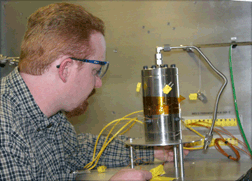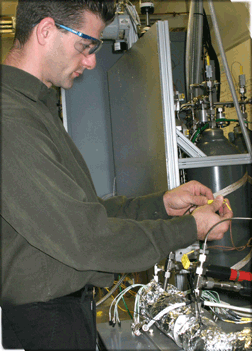NEWS RELEASES
FOR IMMEDIATE RELEASE — January 7, 2005
Media Contact: Mike Janes, mejanes@sandia.gov, 925-294-2447
GM joins with Sandia to advance hydrogen storage
Partnership focuses on solid-state storage
 A critical aspect of hydride storage tank development is the act of recharging and discharging hydrogen. Here, Sandia National Laboratories engineer Mark Zimmerman integrates a hydride bed with temperature monitoring sensors. (Photo by Bud Pelletier)
Download 300dpi JPEG image, 'Mark-Zimmerman.jpg', 796K (Media are welcome to download/publish this image with related news stories.)
A critical aspect of hydride storage tank development is the act of recharging and discharging hydrogen. Here, Sandia National Laboratories engineer Mark Zimmerman integrates a hydride bed with temperature monitoring sensors. (Photo by Bud Pelletier)
Download 300dpi JPEG image, 'Mark-Zimmerman.jpg', 796K (Media are welcome to download/publish this image with related news stories.)DETROIT, Mich., and LIVERMORE, Calif. — General Motors Corp. and Sandia National Laboratories have launched a partnership to design and test an advanced method for storing hydrogen based on metal hydrides.
Metal hydrides — formed when metal alloys are combined with hydrogen — can absorb and store hydrogen within their structures. When subjected to heat, the hydrides release their hydrogen. In a fuel cell system, the hydrogen can then be combined with oxygen to produce electricity.
GM and Sandia, a National Nuclear Security Administration lab, have embarked on a 4-year, $10 million program to develop and test tanks that store hydrogen in a complex hydride, sodium aluminum hydride — or sodium alanate for short. The goal is to develop a pre-prototype solid-state hydrogen storage tank that would store more hydrogen onboard a fuel cell vehicle than current conventional hydrogen storage methods. Researchers also hope to create a tank design that could be adaptable to any type of solid-state hydrogen storage.
"Hydrides have shown significant early promise to one day increase the range of fuel cell vehicles," says Jim Spearot, director, GM Advanced Hydrogen Storage Program. "We know a lot of research still needs to be done, both on the types of hydrides we use, as well as the tanks we store them in. We think our work on projects like this with Sandia will get us another step closer to our goal."
 Recharging of the hydrides and release of the hydrogen from metal hydrides such as sodium alanate requires heat, which can reduce overall fuel economy. Sandia National Laboratories engineer Terry Johnson sets up a test apparatus that, when verified, will generate external heat that improves the overall energy density compared to traditional heat sources. (Photo by Bud Pelletier)
Recharging of the hydrides and release of the hydrogen from metal hydrides such as sodium alanate requires heat, which can reduce overall fuel economy. Sandia National Laboratories engineer Terry Johnson sets up a test apparatus that, when verified, will generate external heat that improves the overall energy density compared to traditional heat sources. (Photo by Bud Pelletier) Download 300dpi JPEG image, 'Johnson2.jpg', 888K (Media are welcome to download/publish this image with related news stories.)
GM and Sandia say the program is part of a concerted effort to find a way to store enough hydrogen onboard a fuel cell vehicle to equal the driving range obtained from a tank of gas, which will be key to customer acceptance of fuel cell vehicles.
The current leading methods of storage are liquid and compressed gas. However, to date, neither of these technologies has been able to provide the needed range and running time for fuel cell vehicles.
"We are designing a hydrogen storage system with challenging thermal management requirements and limits on volume and weight," says Chris Moen, manager of science and engineering technologies at Sandia. "Our staff researchers are excited to apply their unique, science-based design and analysis capabilities to engineer a viable solution."
"This is the kind of public private research partnership that will help us realize the President's vision, communicated in his 2003 State of the Union Address, that 'the first car driven by a child born today can be powered by hydrogen, and pollution-free,'" said DOE Secretary Spencer Abraham. "Over the long term, because of the President's visionary leadership, clean, efficient hydrogen fuel technologies like this will help make our nation far less reliant on foreign sources of energy."
In 2003, President Bush announced the Hydrogen Fuel Initiative with $1.2 billion over five years (FY 2004-FY 2008) to accelerate hydrogen research. Sandia's research activities in hydrogen storage support the President's long term vision for commercially viable hydrogen-powered vehicles to reverse America's growing dependence on foreign oil.
The GM-Sandia project, privately funded and separate from the President's initiative, will be conducted in two phases. In Phase One, the program will study engineering designs for a sodium alanate storage tank. Researchers will analyze these designs using thermal and mechanical modeling, develop controls systems for hydrogen transfer and storage, and develop designs for external heat management. GM and Sandia scientists will also be testing various shapes — from cylindrical to semi-conformable — to see which are the most promising.
In Phase Two, researchers will subject promising tank designs to rigorous safety testing and ultimately fabricate pre-prototype sodium alanate hydrogen storage tanks based on knowledge gained from the program?s first phase.
A possible scenario for filling up with a solid-state storage solution such as sodium alanate could look like this: The alanate would come preloaded in the tank, where it would remain, giving up its hydrogen, and becoming a mixture of sodium hydride and aluminum. The customer would fill up using gaseous hydrogen. During filling, the mixture of aluminum and sodium hydride would absorb the hydrogen and turn it back into alanate, which would be ready to yield hydrogen when needed by the fuel cell. Once the tank is filled, the hydrogen would be stored at low pressure.
While it has shown good potential, hydride-based hydrogen storage also has some hurdles to clear. One current drawback is that most complex metal hydrides, such as sodium alanate, still operate at too high a temperature, which causes an inefficiency that forces some of the hydrogen to be used up in order to release the remaining hydrogen. Another challenge is reducing the time it takes to reabsorb hydrogen. It currently takes at least 30 minutes to recharge.
In separate, independent projects outside of this collaboration, both GM and Sandia are working to identify alloys that will store greater amounts of hydrogen that can be released at lower temperatures. Reducing filling and recharging times is another key area of research.
The research conducted through the GM-Sandia partnership is independent from that of Sandia's participation in the Metal Hydride Center of Excellence. The Center of Excellence, to be funded in Fiscal Year 2005 through a U.S. Department of Energy "Grand Challenge," aims to develop a new class of materials capable of storing hydrogen safely and economically.
General Motors Corp. (NYSE: GM), the world's largest vehicle manufacturer, employs about 325,000 people globally. Founded in 1908, GM has been the global automotive sales leader since 1931. GM today has manufacturing operations in 32 countries and its vehicles are sold in 192 countries. In 2003, GM sold nearly 8.6 million cars and trucks, about 15 percent of the global vehicle market. GM's global headquarters are at the GM Renaissance Center in Detroit. More information on GM and its products can be found on the company's corporate website at www.gm.com.
Sandia is a multiprogram laboratory operated by Sandia Corporation, a Lockheed Martin company, for the U.S. Department of Energy's National Nuclear Security Administration. Sandia has major R& D responsibilities in national security, energy and environmental technologies, and economic competitiveness.